
Trouble ahead: Container shipping rates sinking further into the red
It’s not looking good for container shipping lines. Peak season is running out of whatever limited steam it previously had. Spot rates are sliding into loss-making territory.
Rates “continue to lose ground, bending under the pressure of insufficient demand and growing overcapacity,” said Alphaliner this week.
According to Linerlytica, “Container market sentiment continues to deteriorate, with freight rates still slipping and little prospect for a rate rebound in October despite carriers’ efforts to contain capacity availability through blanked [canceled] sailings.”
This is particularly bad news for ocean carrier Zim which has unusually high spot exposure in the trans-Pacific this year — 70% versus the typical 50%.
Sinking rates to both US and Europe
The Freightos Baltic Daily Index (FBX) spot assessment for the Asia-North America West Coast lane has fallen 16% over the past month, to $1,712 per forty-foot equivalent unit as of Thursday. The FBX Asia-North America East Coast assessment is down 13% over the past month, to $2,662 per FEU.
Asia-Europe lanes are seeing double-digit pullbacks as well.
“For North Europe, we have not seen the spot rate this low since early 2018, when the level was lower for a brief two weeks,” Lars Jensen, CEO of Vespucci Maritime, said in an online post on Thursday. “To see a more sustained period of spot rates this low or lower, we have to go back to the depths of the price war in late 2015 and early 2016.”
The Drewry World Container Index (WCI) shows that European trades are faring even worse than the U.S. trades. WCI spot indexes hit a recent peak on Aug. 17. Since then, the WCI assessment for Shanghai to Rotterdam, Netherlands, has plunged 34%. Spot prices from Shanghai to Genoa, Italy, have dropped 27%.
The WCI’s Shanghai-Los Angeles assessments have declined 11% since Aug. 17, to $2,104 per FEU for the week ending Thursday. The WCI Shanghai-New York index dropped 18% over the same period, to $2,900 per FEU.
Spot levels fall back toward contract levels
Ocean carriers saw some green shoots in July and August as trans-Pacific spot levels rebounded to above annual contract rates. Carrier executives said they did not lock in loss-making rates in their annual contract negotiations, implying that if spot rates exceeded contract rates, the spot business was back in the black.
But the premium of spot rates to contract rates in the Asia-East Coast trade has collapsed over the past month, according to data from Xeneta.
Xeneta data shows that average short-term (spot) rates in the Asia-East Coast trade were an impressive $580 per FEU higher than average long-term (contract) rates on Aug. 15.
No longer. Short-term rates were just $77 per FEU higher than long-term rates as of Thursday. (The spot-to-contract premium is still material in the Asia-West Coast lane, at $283 per FEU.)
Fallout for Zim
The deteriorating spot market in the Asia-East Coast trade via the Panama Canal is particularly worrisome for ocean carrier Zim, because that’s the trans-Pacific trade it’s focused on.
Zim ceased the last of its services to the U.S. West Coast in the first quarter and has deployed its newbuildings on the East Coast route. The Asia-East Coast market is Zim’s most important global trade by far, accounting for 34% of total volume in Q2 2023.
Zim has an unusually high 70% of its trans-Pacific business on spot this year because it could not find enough customers to meet the minimum price threshold it had set for annual contracts (which run from May 1, 2023, to April 30, 2024).
At the time of its latest quarterly call, on Aug. 16, spot rates exceeded contract rates, so Zim was temporarily benefiting from its decision on the spot-contract mix. However, Zim CFO Xavier Destriau openly acknowledged that this could change.
“We remain extremely cautious. How long the recent improvement in the trans-Pacific trade lane will stick is unknown. Whether it’s going to go beyond October or not is unknown,” he said.
The latest index data implies that Zim’s caution was justified and its bet on the spot trade could indeed turn negative, if it hasn’t already.
